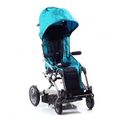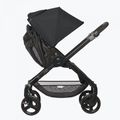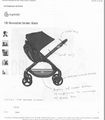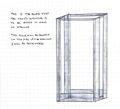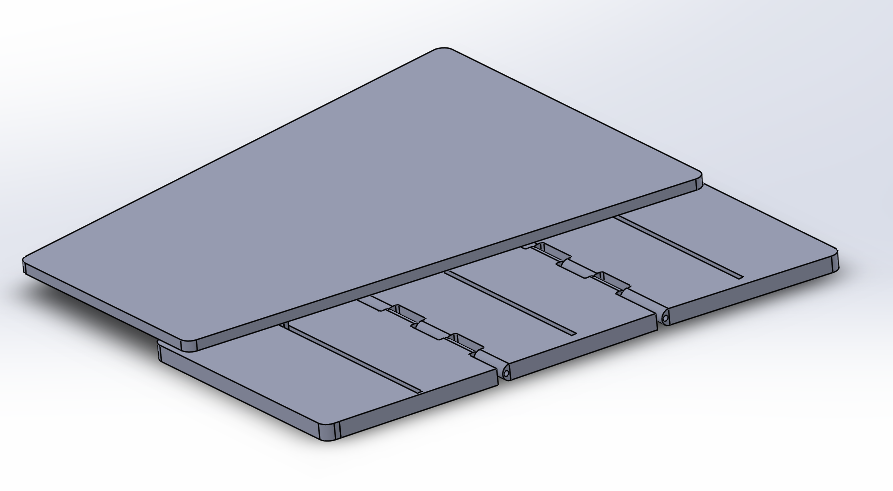Adaptive Stroller
Contents |
Abstract
Andrew is an infant who is 7 months old and has Trisomy 18. Trisomy 18 occurs when an extra 18th chromosome is present. This can lead to failure in organs resulting in the need of a respirator, ventilator, and feeding tube. His parents would like a stroller that can carry all his equipment so they may go out an do stuff with him.
Team members
- Brooks Browning
- Ethan Fralix
- Jaymin Patel
- Justin Simmons
- Logan Barber
Problem Statement/overview of the need
Andrew needs a respirator all the time which can make it difficult for his parents to go on errands. Andrew's parents would like a stroller that would allow them to carry all his medical equipment with them when they are on the go.
Design Specifications
- Support the weight of a respirator, feeding pump, ventilator, and heart monitor.
- Hold a battery large enough so they may be out extensive periods of time if need be.
- Stroller needs to hold the weigh of the infant.
- The wheels cannot be rubber per request of the parents, and this way no holes can puncture the wheels.
- The stroller needs to be able to fold for easy storage.
Background research
There are medical strollers, but they are expensive, some costing up to $2,000. This team of engineers is hoping to drop that cost significantly by making taking a stroller and adding a way to attach the equipment to the stroller.
Conceptual Design
We are current thinking about taking a stroller, preferably one with a steel or aluminum frame, and adding attachments to it so we can attach the medical equipment to it.
Concept 1
This is the stroller that we were thinking about using. It is called the Ergobaby 180. It is a reversible stroller with hard wheels, a cupholder, and is able to support a child from birth to fifty pounds according to Ergobaby's website. The frame appears to steel with is perfect so we may add the medical equipment to the stroller.
Concept 2
This stroller was another stroller the family considered. It is called the Uppa Baby Cruz. It is easier to modify, however it more expensive.
Concept 3
The stroller will need a bag to hold the devices. So far we have the idea of multiple bags, one for each device.
The second option is make one bag for all the devices. The problem with this concept is that the weight may become unbalanced. As of now we are thinking about attaching the bags to the stroller using velcro for easy placement and easy removal.
In both cases the bags need to water proof and zip on 3 sides at the top. We will probably add velcro one the "tongue" of the bag for extra security.
Concept 4
Wheels: The parents have requesting non rubber wheels. To solve this issue we are considering aluminum wheels and wrapping them with some sort of tread. To reduce cost we could plastic, however, the plastic could break easily.
Tray: The stroller will also need a tray to place items on. The tray will have a jagged tooth design that will allow the stroller to be easily folded. The platform will either fold in one place or multiple places. If it folds in multiple places it will easier to fold and the pieces for the platform will be smaller. The downside is that it could make it difficult to lock the tray so it does not fold while the stroller is in use.
Battery Pack: The battery pack will have to be purchased. We will need one that have multiple ports for each device. Otherwise we will have to find a USB cable that splices into three different USB female ports. The issue with multiple ports is that the batter may not be able to handle it which could lead to fire hazards. The most desirable option is the batter with multiple ports.
Detailed Design
This section will describe a detailed design process
We plan to remove the mesh net at the bottom of the stroller and replace it with a foldable metal platform. The platform will hold the machines the child needs. We plan to attach a second platform to hold the heaviest machine, the OxyLife. We will have to place each machine in a certain area to maintain a center of gravity of the rectangle the stroller makes.
Detailed description of selected design
Description of selected Design: In This design modification we intend to take a stand with the elegant Ergobaby 180 with all its amazing features. The caretaker has also recommended it personally. Our after-purchase modification will be to suit the child’s needs which are to be able to hold his medical equipment as well as have some comfort while being inside the stroller. The idea is to take the mesh out at the very bottom and replace it with some solid-foldable metal of which is very strong, yet docile, while remaining cheap. Some ideas we have for this is aluminum, a reinforced plastic of sorts, and perhaps an alloy to prevent rusting. We want to be able to position his equipment such that it keeps the center of gravity over the rectangle the stroller makes. This will be vital when the child is being pushed along because it will keep the weight evenly distributed across the center and expand the life of the stroller; this will also help the user not get tired as quickly either. Another strong idea we had was to reinforce the bottom of the frame as well to give it that extra strength it needs to carry a couple additional things, taking into consideration the factors of safety design will work nicely while doing this. This seems like a strong start for the design process and modification. We have a nice follow up on this as well after purchase as we have already priced it out and taken into consideration the weights of the medical equipment summed up. Once the ergo baby is in hand and we begin fabrication we will perform some simple force analysis, such as a static balance when it is in its ideal setting just to see how well it will hold up against the load it will carry. This sums up our thought process thus far on the selected design process.
Analysis
Describe three types of analysis to be performed on the design
Engineering analysis 1
Engineering analysis 2
Engineering analysis 3
CAD Drawings
Bill of Materials
Assembly Instructions
Fabrication Process
Insert pictures of fabrication process
Testing and implementation
Describe testing, delivery, how used/received by the family
Photos of Completed design
Insert pictures of the final product
Instructions for safe use
Provide a clear summary of safe use for the family. Do not use the device unless supervised by an adult that has been fully understood the safe use of this product.

